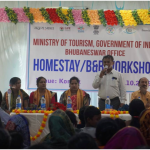
BY DR. RAVINDER PALL SAINI
INDIAN FOREST SERVICE ( RETIRED)
MEMBER, BOARD OF MANAGEMENT,
FOREST RESEARCH UNIVERSITY,
DEHRADUN.
DEHRADUN, 1 MAY 2023:
HARIDWAR and RISHIKESH :
Haridwar is an archaic city and important Hindu pilgrimage place in North India’s Uttarakhand state, on the banks of the Holy and most revered river Ganges. A nirvana abode for nature-lovers, Haridwar presents kaleidoscope of Indian culture and civilization. Haridwar also termed as ‘Gateway to Gods’ is known as Mayapuri, Kapila, Gangadwar as well. The followers of Lord Shiva (Har) and followers of Lord Vishnu (Hari) pronounce this place Hardwar and Hardwar respectively as told by some. It is also an entry point to Dev Bhoomi and Char Dham (Four main centres of pilgrimage in Uttarakhand) Viz. Badrinath, Kedarnath, Gangotri and Yamunotri.

Haridwar is at 29.945°N 78.163°E. It has an average elevation of 314 metres (1,046 ft). The town is in the Tehri Garhwal region of the northern Indian state of Uttarakhand.

Mythological king Bhagirath is said to have brought the river Ganga from heaven to earth to provide salvation to his ancestors. It is also said that Haridwar has been sanctified by the presence of three Gods: Brahma, Vishnu, and Mahesh. Lord Vishnu is said to have his footprint on the stone that is set in the upper wall of Har-Ki-Pauri where the Holy Ganga touches it all the time. Devout believers feel that they can go to heaven by getting their salvation after a dip in the sacred Ganga at Haridwar.

Haridwar is also one of the four places, where Kumbh Mela occurs after rotation of every twelve Years and Ardh Kumbh after every six years. It is said that drops of Amrit (Elixir) fell in to the Brahmkund of Har-Ki-Pauri, therefore considered that a dip in the Brahmakund on this day which is very auspicious and when Jupiter (Brahaspati) comes to the sign Aquarius (Kumbh) once in every twelve years the Maha Kumbh fair is celebrated at Haridwar. Yet beyond the mystic aura and mythology, Haridwar casts another magic spell on the visitor. Being one of the oldest living cities, Haridwar finds its mention in the ancient Hindu scriptures as it waves through the life and time stretching from the period of the Buddha to the more recent British advent. Haridwar has not only remained the abode of the weary in body, mind, and spirit, but also served as centre of attraction for many, for learning the arts science and culture. Haridwar’s long standing position as a great source for Ayurvedic medicines and herbal remedies as well as its unique Gurukul school of traditional education, the scenic beauty and lush greenery.

According to Puranic legend, Haridwar, along with Ujjain, Nashik, and Prayag, is one of four sites where drops of amrita, the elixir of immortality, accidentally spilled over from a kumbha (pitcher) while being carried by the celestial bird Garuda during the Samudra Manthan, or the churning of the ocean of milk. Brahma Kund, the spot where the amrita fell, is believed to be located at Har ki Pauri (literally, "footsteps of the Lord") and is the most sacred ghat of Haridwar. It is also the primary centre of the Kanwar pilgrimage, in which millions of participants gather sacred water from the Ganges and carry it across hundreds of miles to dispense as offerings in Shiva shrines.

Haridwar is one of the first towns where Ganga emerges from the mountains to touch the planes. And that’s why the water is crystal clear and cool. Lush green forests and small ponds add to the scenic beauty of this holy land. The Rajaji National Park is just 10 kms from Haridwar. It’s an ideal destination for wildlife and adventure lovers. In the evening the ghats look breathtakingly beautiful as thousands of diyas (lamps) and marigold flowers float and illuminate the holy waters.

Haridwar as today has not only religious importance, but it has another temple of modern civilization i.e., BHEL, a ‘Navratna PSU’ to its credit apart from Integrated Industrial Estate (IIE) established at Haridwar under SIIDCUL spread in total area of about 2034 acres.

The IIT Roorkee (Earlier Roorkee University) at Roorkee is one of the oldest and prestigious institute of learning in the fields of science and engineering. Another university of the district i.e., Gurukul having vast campus is giving traditional educations of its own kind.

Rishikesh is a holy city in India’s neighbouring Haridwar and often considered as twin holy cities on Ganges arrival on Himalayan foothills. It is known as the “Gateway to the Garhwal H imalayas” and “Yoga Capital of the World”. The city has hosted the annual “International Yoga Festival” on the first week of March since 1999.

Rishikesh is at 30.103368°N 78.294754°E. It has an average elevation of 340 metres (1,120 ft). The town is in the Tehri Garhwal region of the northern Indian state of Uttarakhand. Rishikesh was part of the legendary “Kedarkhand” mentioned in the Skanda Purana.

Legends state that Lord Rama did penance here for killing Ravana, the asura king of Lanka. Lakshmana, Rama’s younger brother, crossed the Ganges using two jute ropes at the point where the present Lakshman Jhula suspension bridge stands today. Lakshman Jhula also collapsed in 2020. And a much stronger, 2nd in the whole of India, a glass bridge, is being built across the river. The 248-foot-long iron-rope suspension bridge built in 1889 was washed away by flooding in 1924. In 1927, it was replaced by the current, stronger bridge built by the United Provinces Public Works Department, connecting the Tapovan, Tehri, and Pauri Garhwal districts. A noted suspension bridge named Ram Jhula was built in 1986 at the nearby Sivananda Nagar. The Skanda Purana also mentions the site as “Indrakund”; where Indra underwent a holy bath to remove a curse.

The Ganges, one of the most sacred rivers to Hindus, flows through Rishikesh in its course from the Shivalik Hills of the Himalayas to the plains of northern India with temples built along the banks. Shatrughna Mandir, Bharat Mandir, and Lakshman Mandir are the ancient temples established by Adi Shankaracharya. Shatrughna Temple is near the Ram Jhula suspension bridge, while Lakshman Mandir is situated near the Lakshman Jhula suspension bridge. The historical records mention that some pilgrims used to stay at Rishikesh, either seeking the site itself or using it as a resting place before moving onwards to the Himalayas.

Both the cities are well connected by Air, Rail and Road with rest of the country.


Advertisement:






























Add Comment